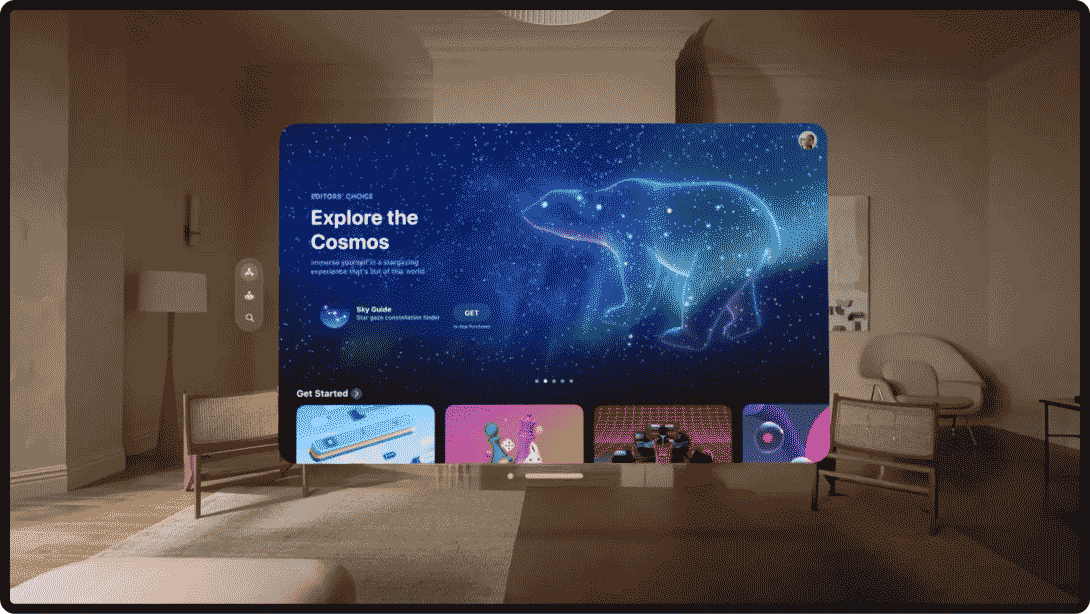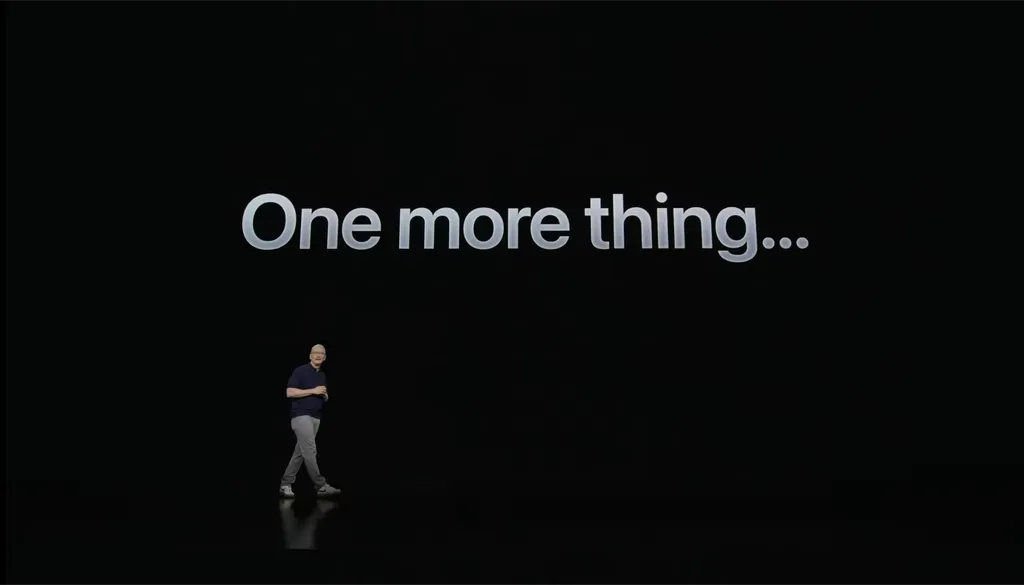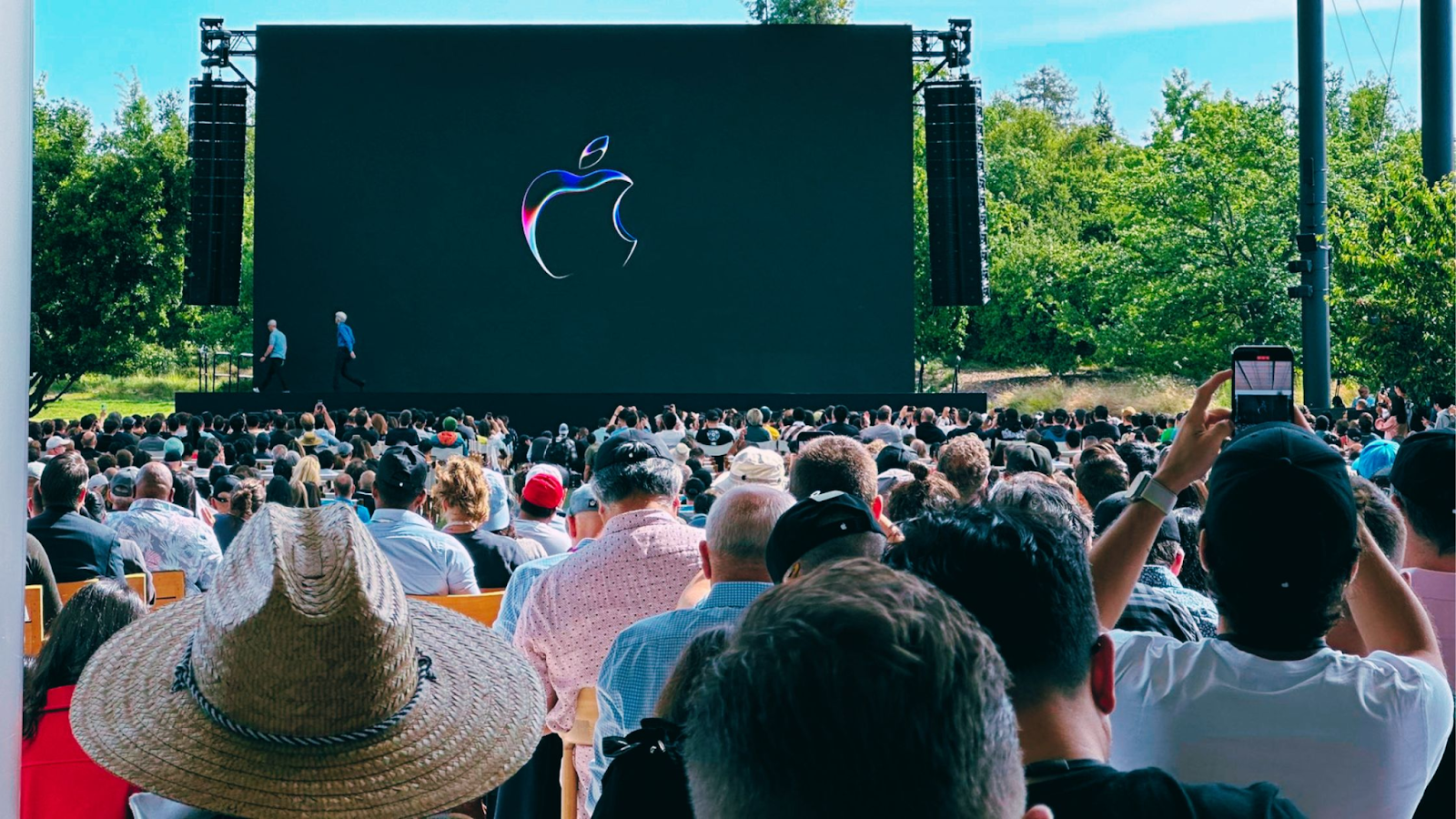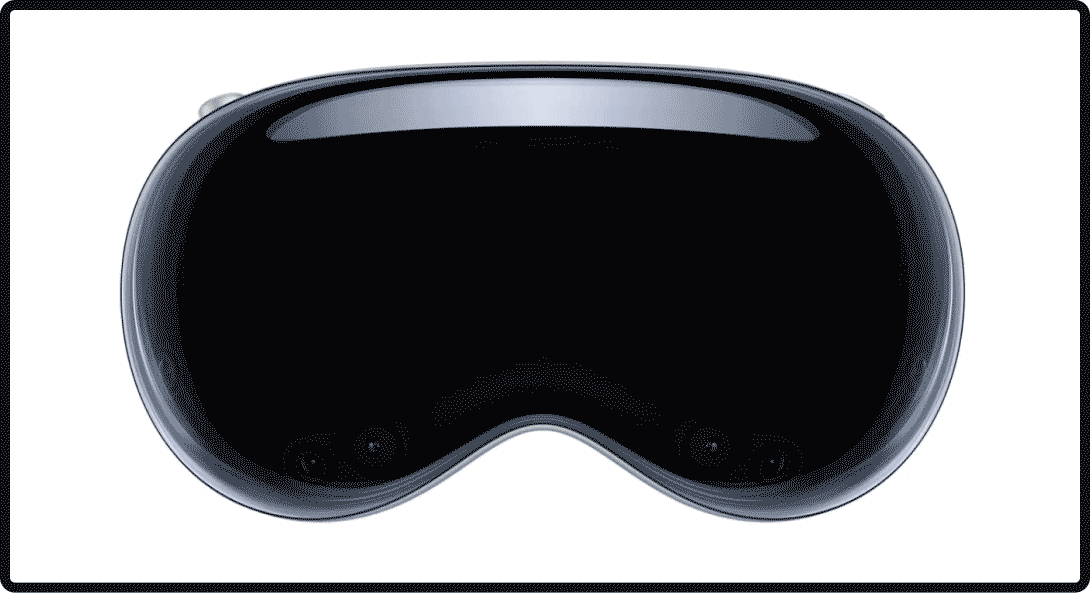Apple’s genius lies in its innovation and ability to captivate the world with mesmerizing launch events and strategic messaging. Here is a deep dive into their infamous pricing strategy, their art of launching a new product, and how you can use their GTM strategy to dominate your market.
What Does the Apple Vision Pro Do?

Apple Vision Pro revolutionizes digital content interaction through eye, hand, and voice commands. The device integrates advanced technology into a compact, elegant form for an exceptional user experience. The design features a sleek glass enclosure with an aluminum alloy frame and a flexible Light Seal for comfort and precise fit. The device also offers impressive battery life and delivers immersive Spatial Audio without compromising awareness of surroundings.
EyeSight, a prominent feature, incorporates an outward display and lets others know when the user is engaged. The device runs on visionOS, built on macOS, iOS, and iPadOS, ensuring intuitive and magical interactions while prioritizing privacy and security. Features like Optic ID enhance privacy and security through secure authentication leveraging the user’s iris.
Specific features of Apple Vision Pro include app experiences, arranging apps on the screen, and bringing 3D objects to life. The device integrates with Mac through Mac Virtual Display, creating a portable 4K display. It also works harmoniously with Bluetooth accessories for enhanced user experience.
In terms of entertainment, Vision Pro transforms any room into a theater with stunning visuals, Spatial Audio, and expansive screen sizes. It introduces Apple Immersive Videos, capturing scenes in 180-degree 3D at 8K resolution. Users can access movies and TV shows from Apple TV+ and other streaming services, while gaming enthusiasts can enjoy visionOS games on Apple Arcade with interactive possibilities.
For photography and videography, Vision Pro enables spatial capturing of photos and videos with immersive Spatial Audio integration. Collaboration and connection are made easy with life-size FaceTime video tiles, collaborative apps, and Spatial Audio for natural conversations. The device also features a digital Persona that reflects facial expressions and hand movements during interactions in FaceTime calls.
Launching the Apple Vision Pro
Every year, in early June, Apple’s highly anticipated Worldwide Developers Conference (WWDC) takes center stage, unveiling many exciting new products from the tech giant, such as the highly anticipated release of the Apple Vision Pro. This device is poised to be Apple’s first foray into the VR world, captivating the imaginations of tech enthusiasts and consumers alike. The Apple Vision Pro has sparked a sense of anticipation and excitement as people eagerly await its official launch.
The Big Event Reveal

Exciting updates were disclosed during the event, including the availability of developer betas for all major operating systems. The public beta versions are scheduled to be released in July 2023, building anticipation for the fall release. This extended-release encompasses MacOS, iPadOS, WatchOS, and iOS updates, promising a wealth of new features and enhancements across Apple’s ecosystem.
In conclusion to WWDC 2023, Tim Cook, CEO of Apple, took to the stage and unveiled the highly anticipated Apple Vision Pro VR/AR Mixed Reality headset. With great excitement, Tim Cook delivered the iconic “one more thing” announcement, a moment that has become synonymous with Apple’s most groundbreaking unveilings. The announcement of the Apple Vision Pro sent waves of delight throughout the event, solidifying its position as a game-changing addition to Apple’s innovative product lineup.
Redefining the future of VR with a high-production intro video
The launch video for Apple’s Vision Pro mixed reality headset has received praise for its high production value and relatable portrayal of everyday use cases. Unlike Meta’s Metaverse launch video, Apple’s video focuses on aspirational lifestyles and seamlessly integrating VR into daily life.
The video showcases attractive models in luxurious settings, presenting an image of sophistication and desirability. Apple avoids the awkwardness associated with VR by projecting the user’s eyes onto the headset’s exterior, addressing the “ick” factor and making the experience more inclusive. The video highlights practical applications such as immersive TV viewing, browsing personal videos, and even conducting work meetings through FaceTime.
Gaming, typically associated with VR, is given minimal attention in the video, as Apple aims to showcase how VR can enhance everyday experiences rather than focusing solely on gaming.
In his presentation, Tim Cook highlights the Vision Pro’s immersive nature, positioning it as a device that enhances real-life engagement rather than detracting from it. By emphasizing that users look through the device rather than at it, Apple aims to differentiate the Vision Pro from traditional smartphones.
Despite criticisms and skepticism from some commentators, Apple’s launch video effectively captures the attention and interest of consumers, enticing them to consider the Vision Pro as a desirable and relevant tech gadget.
Creating a Buzz: Apple’s Exclusive Access and Influencer Magic

Apple’s approach to launching the Apple Vision Pro through a PR and influencer campaign showcases its understanding of the importance of media coverage and strategic messaging. Despite being a dominant company, Apple recognizes the value of engaging with influencers and sharing its innovations through various outlets.
Apple’s deliberate and carefully choreographed public appearances and events demonstrate its commitment to delivering a cohesive and controlled message. They meticulously plan every second of these appearances to ensure their key messages are conveyed effectively. Regardless of the topics raised, such as pricing, innovation, supply chain, or environmental impact, Apple executives remain focused on their predetermined key messages, maintaining consistency in their communication.
In terms of providing access to the device, Apple’s decision to allow the press and influencers to experience the technology at WWDC while limiting video footage capturing was a brilliant move. By granting exclusive access and making influencers and PR personnel feel special, Apple generates a sense of anticipation and desire for the product. This strategy effectively creates buzz and excitement around the Apple Vision Pro.
How much does the Apple Vision Pro cost?
The curtain was lifted on the price of the Apple Vision Pro during its grand reveal at WWDC, leaving the audience in awe. As the announcement echoed through the room, a collective gasp reverberated, marking a moment of astonishment. The initial price tag for this cutting-edge device was unveiled, starting at $3499, leaving some wondering about the reasoning behind this seemingly bold pricing strategy.
While the price may initially appear daring, there is a method to this perceived “pricing madness.”
A Strategic Pricing Strategy
Apple’s pricing strategy for the Vision Pro headset may seem absurdly high at $3,499, as it exceeds the combined cost of an iPhone 14 Pro Max, a 12.9-inch iPad Pro, and an Apple Watch Ultra, but it aligns with a proven and strategic approach
Matthew Ball, an investor in the metaverse world and advisor, suggests that Apple is taking the “Tesla approach” by starting with a premium offering and gradually lowering the price while improving performance.
Tesla’s pricing strategy is characterized by an innovative approach devised by Elon Musk. It deviates from conventional methods by embracing a dynamic pricing model, wherein prices can fluctuate unexpectedly, not solely determined by factors like costs, supply, and demand. The strategy commences with setting higher prices initially, aiming to achieve greater profit margins by targeting affluent customers interested in high-end vehicles. Subsequently, Tesla introduces lower-priced electric cars to capture a larger market share, ultimately maximizing profits. This sequential life cycle approach enables Tesla to attain high sales volumes and expand its presence in the market.
Historically, Apple has successfully employed a strategy called “price skimming.” This strategy allows Apple to capture early adopters willing to pay a premium for the latest technology. By setting high prices initially, Apple maximizes profits during the product’s early lifecycle. As the product matures, the price is gradually reduced to attract more price-sensitive consumers, ensuring profitability across all market segments.
Moreover, this pricing approach reinforces Apple’s luxury and aspirational brand image. It signals that Apple competes based on quality, design, and user experience rather than price. The high profits from initial sales also fuel Apple’s ongoing research and development efforts, enabling the company to stay ahead of the competition and maintain its market dominance.
Yet, from a psychological standpoint, this seemingly exorbitant price tag holds a certain strategic allure. Let’s explore why this pricing strategy makes sense and how Apple leverages the contrast principle to shape our perceptions.
The contrast principle is a cognitive bias in psychology that influences our perception of something based on its contrast with a recently encountered reference point. In the realm of retail, this principle is often employed to entice consumers into purchasing more. For instance, when shopping for clothes, retailers tend to present high-priced items first, such as an expensive suit. Despite the apparent contrast, customers who have already committed to a significant purchase, like the suit, are more likely to perceive related accessories, such as belts or shoes, as less expensive. This is because they mentally compare the prices of these items to the suit, making the accessories appear relatively affordable.
Apple adopts a similar strategy with the Vision Pro headset. Introducing a premium-priced device first establishes a reference point that sets a high perceived value for the product line.
Apple CEO Tim Cook himself acknowledged the Vision Pro’s price during an interview, acknowledging that people will make different choices based on their financial situations. This acknowledgment recognizes the exclusivity of the device and acknowledges that it may not be within reach for everyone. However, the strategic pricing remains anchored in the psychological principles of contrast, making future iterations or alternative versions of the headset appear more affordable when compared to the initial premium offering.
Ultimately, Apple’s pricing strategy for the Vision Pro aligns with its commitment to innovation, brand positioning, and profitability. While the initial price may be out of reach for many, it reflects the device’s advanced capabilities and exceptional user experience.
The Art of Launching a New Product
Apple has mastered the art of launching new products by employing specific strategies that consistently captivate consumers and create blockbuster-like experiences. Their success lies in simplicity, continuity, and adherence to their mission statement.
One of Apple’s tactics is hosting proprietary events solely dedicated to its product launches. They generate excitement and anticipation by making consumers wait and go big with these events. They also leverage stealth marketing efforts, influencing industry events like CES by dropping hints and announcements to keep the rumor mill active, ensuring high attendance.
Apple’s commitment to its vision statement is another key aspect of its strategy. They only launch products that align 100% with their mission, saying no to thousands of projects. Powerful partnerships further support their business approach, allowing other brands to launch Apple’s innovations in their own products. This strategy demonstrates the effectiveness of collaboration in launching successful innovations.
Having a global perspective is crucial for Apple. Understanding the needs of specific markets, they tailor their launches to resonate with the target audience. Decoding the needs of your desired demographic and focusing launches accordingly can be a tactic for success.
While Apple may only invent some of the technologies they utilize, they excel at fine-tuning innovations for market consumption. Their launches emphasize how they do things better, highlighting the user experience and customer service alongside the tech itself.
Apple’s product launches incorporate captivating content elements, such as colorful and diverse live-streamed videos and presentations from immersive 3D environments. The quality of the content plays a significant role in creating impactful launches.
Furthermore, Apple recognizes the power of apps and incorporates them into their launches. By showcasing the versatility of iOS capabilities and providing an app for the launch itself, they engage consumers and allow them to explore the breadth of their products.
Overall, Apple’s art of launching new products revolves around simplicity, continuity, strategic tactics, business principles, technology refinement, captivating content, and embracing digital platforms.
How to Achieve Market Domination
Achieving market domination requires a comprehensive approach that considers various factors and employs effective strategies. By summarizing the key points from Apple’s business strategy, we can gain insights into the path toward market dominance.
2. Perform a thorough competitive analysis
4. Establish a unique value position (UVP)
5. Provide exceptional customer service
6. Be innovative and embrace technology
1. Define your target market
It is crucial to identify and target specific sub-markets. Apple understands this concept well, as it initially conquered smaller niches before expanding its reach to a larger audience. For instance, Apple started by focusing on the niche market of creative professionals with the launch of the Apple Vision Pro, catering to their specific needs and preferences.
2. Perform a thorough competitive analysis
Understanding your competition is vital for maintaining a competitive advantage. Apple continuously analyzes its competitors to identify weaknesses and capitalize on them. By incorporating competitive analysis into its marketing plan, Apple stays ahead of the curve and ensures market dominance.
3. Create a niche
Establishing a niche market can be an effective strategy for dominating the overall market. Apple has successfully created its niche by developing products in a league of its own. They have differentiated themselves from competitors by offering a unique ecosystem of devices, software, and services. The Apple Vision Pro caters to a niche audience of professionals prioritizing productivity, creativity, and seamless integration within the Apple ecosystem.
4. Establish a unique value position (UVP)
Dominating a market requires a strong value proposition and differentiation. Apple has excelled in product positioning by offering unique value to customers. They combine innovative features, user-friendly design, and superior quality, setting themselves apart from competitors. The Apple Vision Pro’s UVP lies in its advanced technology, seamless integration with other Apple devices, and exceptional user experience.
5. Provide exceptional customer service
Apple excels in providing exceptional customer service through personalized communication, active feedback strategies, and continuous improvement. Their focus on customer satisfaction has fostered loyalty and advocacy.
6. Be innovative and embrace technology
Staying ahead of technological advancements is crucial for sustained market dominance. Apple has consistently embraced innovation, incorporating new technologies into its products and services. They understand the importance of adopting new technology and meeting evolving customer demands. The Apple Vision Pro showcases Apple’s commitment to leveraging technology to offer cutting-edge solutions for professionals in the visual industry.
What We Can Learn From the Launch of the Apple Vision Pro
The launch of the Apple Vision Pro provides valuable insights into how companies can go to market with tremendous success. By studying the launch of the Apple Vision Pro’s strategies and implementing key principles, businesses can create impactful and memorable launches that resonate with their target audience.
1. Shifting The Emphasis from The Product To The People
2. Getting PR and Influencers on Board
3. Compel Customers to Showcase Your Product
4. Embracing Innovation and Pushing the Boundaries
5. Building Anticipation Surrounding a Product Release
6. Turning the Product Launch Into a Noteworthy Event
1. Shifting The Emphasis from The Product To The People
Apple understands that highlighting how a product can improve people’s lives is more effective than bombarding them with technical details. The company knows that discussing new technical updates will be little help as the customers can quickly look up all the information on their website regardless.
For example, when introducing the Apple Vision Pro, Apple emphasized how the device seamlessly integrates with various functions, simplifying users’ daily lives and enhancing productivity. Companies can build anticipation and excitement around their product launches by highlighting the benefits and impact on customers.
2. Getting PR and Influencers on Board
@ijustine A quick look at the #VisionPro from #Apple! #wwdc23 #applevisionpro ♬ original sound – iJustine
Apple’s ability to involve bloggers and thought leaders before product launches generate buzz and anticipation. Even smaller companies can employ a similar strategy by working with the media in advance, establishing relationships, and building suspense.
For instance, when unveiling the Apple Vision Pro, Apple let niche influencers try the device to include them from the get-go. This approach creates pre-launch discussions, building anticipation and interest among the target audience.
3. Compel Customers to Showcase Your Product

Apple’s attention to design and aesthetics is fundamental to its success, as we’ve seen with the high-quality intro video of the launch. Companies should prioritize the visual appeal of their products, as it greatly influences customers’ desire to share and showcase them.
When launching a new product, businesses should ensure its design is visually appealing, aligning with their target audience’s preferences and aspirations. Aesthetically pleasing products attract attention and generate positive word-of-mouth and online buzz, enhancing the launch’s success.
4. Embracing Innovation and Pushing the Boundaries
Apple’s reputation for innovation and revolutionizing entire industries contributes significantly to the success of its product launches. Every company, regardless of size, has the opportunity to revolutionize their own business and industry.
When launching a new product, companies should strive to offer something unique and imaginative. By taking a bold position, painting a compelling vision of the future, and aligning their entire company behind that vision, they can inspire customers and differentiate themselves in the market.
For example, when introducing the Apple Vision Pro, Apple emphasized how it redefines the concept of AR and VR, revolutionizing how people interact with digital content and blurring the boundaries between the virtual and real world.
5. Building Anticipation Surrounding a Product Release
Apple’s ability to maintain secrecy and generate speculation surrounding its upcoming products creates a sense of mystery and anticipation. Businesses can adopt similar strategies by carefully managing the release of information and building excitement through little details.
By strategically revealing only glimpses of the product and teasing its features over time, companies can build anticipation and curiosity among their target audience. This approach creates buzz and increases the likelihood of a successful launch.
6. Turning the Product Launch Into a Noteworthy Event

Apple transforms its product launches into captivating events that capture attention and generate excitement. Regardless of budget constraints, companies can create their own versions of impactful launch events.
Hosting a press event, whether in-person or online, allows companies to build anticipation, engage their audience, and create a sense of importance around their product launches. By making the launch event a memorable experience, companies can increase the perceived value of their products and generate media coverage. Of course, with the launch of the Apple Vision Pro, Apple executed this at the WWDC.
The launch of the Apple Vision Pro exemplifies key strategies that can be applied to any product launch. By putting the focus on the customers, involving opinion leaders or influencers, being revolutionary, creating memorable events, prioritizing design, and building suspense, companies can elevate their product launches and drive success in the market. While only some companies can replicate Apple’s scale and resources, the principles behind their launch strategies can be adapted to suit businesses of all sizes and industries.






